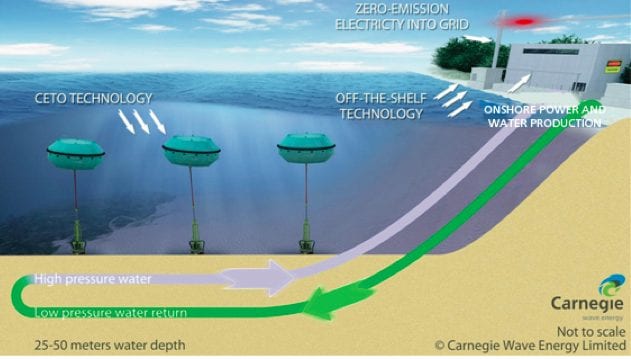Perth-based Carnegie Wave Energy says it will become the first company in the world to build a wave-powered desalination plant, and the first to have a wave energy project that delivers both electrons and fresh water.
The announcement comes after Carnegie signed a “co-operation agreement with the WA-based Water Corporation that will support a pilot desalination project to be built alongside the Perth Wave energy demonstration project that is now being built near the Garden Island naval base near Perth.
Water Corp relies heavily on desalinated water. It built the first large-scale, mainland desalination plant in Australia at Kwinana in 2006, and this year began construction of a second plant at Binningup. Together, these plants will supply 100 billion litres of freshwater to Perth – about half of the city’s drinking water needs.
Water Corp CEO Sue Murphy said desalination was an important part of the city’s long term water supply solution and Carnegie’s CETO technology offered a “novel and promising approach” to producing desalinated freshwater with zero greenhouse gas emissions.
The CETO desalination pilot will integrate off-the-shelf reverse osmosis desalination technology with the infrastructure of the adjoining wave energy project. It will be supported by the $1.27 million in funding from the Federal Government’s AusIndustry Clean Technology Innovation Program.
Combining energy and fresh water has long been touted as a key differentiation for the CETO technology. Carnegie ways combining the two will be cost-effective.
“Carnegie’s wave powered desalination pilot will be a world first,” CEO Michael Ottaviano said in a statement.
The 2MW demonstration project off Garden Island will be the first in the world to deploy multiple wave energy machines.
It will feature the CETO technology, that comprises submerged buoys, 11m in diameter, that are tethered to pumps which deliver pressurised water onshore via an underwater pipe.
There, the water is used to drive hydroelectric turbines, generating zero-emission electricity, or it can be used to supply a reverse osmosis desalination plant, replacing or reducing the reliance on greenhouse gas-emitting, electrically driven pumps.
Carnegie’s share price, which hit a low of 2.8c earlier this year, have more than doubled in recent months. On Tuesday, the shares were trading at 6.5c after a 6.6 per cent gain. The company is now capitalised at around $70 million.









